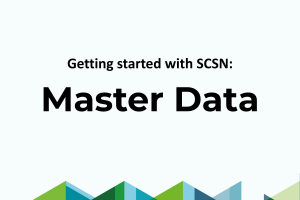Getting started with SCSN: Master Data

Master Data: Obstacle or Opportunity?
While the concept of master data is well known in the industry, we often find that in conversations about digitalization, it’s perceived as a barrier. A common concern we hear is:
“We want to digitize, but our master data isn’t in order yet.”
But how realistic is it to wait until everything is perfect? In this blog, we take a closer look, so that what feels like a barrier might actually become a stepping stone.
What is master data?
Simply put: master data is the set of core information your business needs to keep its processes running smoothly.
Think of things like:
- Article data (such as descriptions, item codes, units, lead times)
- Customer and supplier details
- Price lists and commercial conditions
Why is master data seen as a barrier?
Not every company has its master data fully organized, and that’s completely understandable. Many organizations have complex product structures or have been working with the same data for years.
We often hear concerns like:
"We have 100,000 items, how are we ever going to organise all that?"
"It would take more time to clean up our data than we’d gain through digitalisation."
These are valid concerns, but they’re often based on assumptions. Today, around 430 companies are connected to SCSN, and they all had to start somewhere.
How can you organise master data effectively?
We see different approaches. Some companies hire a master data specialist, while others build an internal digitalization team. But not every organization has the resources for that. Fortunately, there are smart ways to get started.
One piece of advice we often give: start small. Choose a supplier or customer you work with frequently and focus on the most commonly ordered items. By aligning that data, you can often automate up to 80% of your order process with that partner. That’s immediate impact and you’re already active on SCSN.
We’re also seeing more companies use AI tools to support this process. These tools can help identify duplicate or incorrect items, flag missing information (like dimensions or descriptions), and detect pricing inconsistencies. Just keep in mind: always review the results yourself. AI can do a lot, but it’s not perfect.
Does everything need to be perfect before starting with SCSN?
No. You really don’t need to wait until everything is perfect. In fact, starting with a small, well-prepared dataset can already make a big difference. Many companies improve their data along the way, based on practical use.
SCSN actually helps improve your data quality, because it gives you insight into where your data differs from that of your customers or suppliers. That makes your data more reliable and reduces the risk of errors.
Conclusion
Master data is important—but it doesn’t have to be a barrier. By starting smart and improving as you go, you can quickly move toward digital collaboration. The most important thing to remember: you don’t have to get it all right at once.
Start with your most-used items, collaborate with your partners, and experience how simple it can be. That’s how digitalization becomes not just achievable, but immediately valuable.
Don’t think: “Everything has to be perfect.”
Think: “What can I start with tomorrow?”
Because that’s exactly how digital transformation begins.